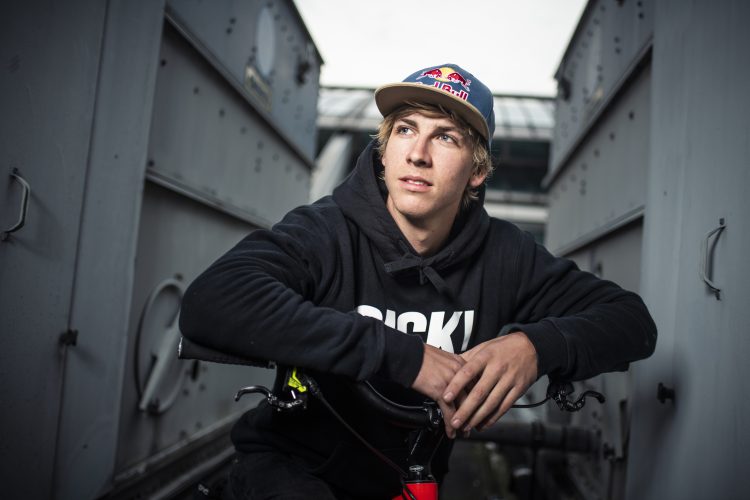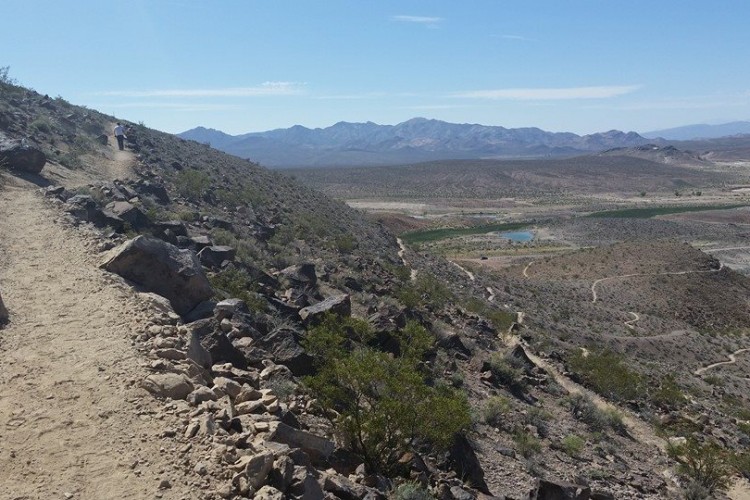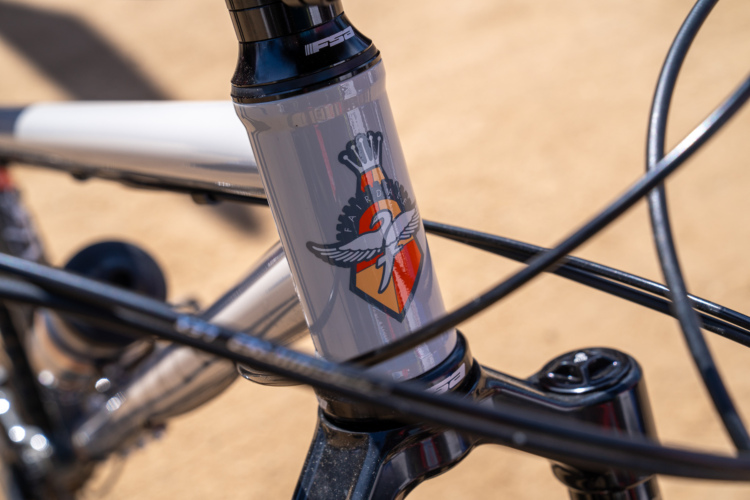
The Willamette National Forest stretches over 100 miles along the slopes of the Cascade Range in Western Oregon, comprising over 1.6 million acres of year-round recreation. The Willamette’s elevation ranges from 1,500 feet on the western edge to nearly 10,500 on the top of Oregon’s second-highest peak, Mount Jefferson. Other major peaks include Mount Washington, Three Fingered Jack, Diamond Peak, and The Sisters (they’re triplets). Over 1,500 miles of river and stream as well as 375 lakes are found within Willamette National Forest. Willamette forest headquarters are located in the city of Springfield with ranger district offices in McKenzie Bridge, Mill City, Detroit, Sweet Home, and Westfir.
Besides some of the mountain biking trails Oregon has to offer, what attracts most riders to the Cascade Range is the flora and fauna. It is estimated that over half of Willamette National Forest is covered in old growth trees. Since the coastal Douglas fir and western red cedar dominate here, you’ll ride under canopies of 300-foot monsters with diameters of up to eight feet. What the Willamette lacks in expansive views, it more than makes up for in scenery closed in by some of the largest, lushest foliage in the world.
The 10 Best Mountain Biking Trails in Willamette National Forest
Lucky for would-be Willamette riders, several of the National Forest’s best trails are concentrated around the small towns of Oakridge and Westfir, OR. Lately, there’s been a ton of buzz about Oakridge-area riding. Here are the best trails you need to ride when you make the pilgrimage:
1. Alpine Trail

Dubbed Oregon’s crown jewel, Alpine is the trail of choice for most riders seeking an all-inclusive package. Although it’s the longest descending trail in Oakridge, an overall elevation gain of 2,000 feet make Alpine’s 15 miles feel more like 30.
Alpine begins with an earnest one-mile grunt (from the shuttle drop-off) before opening up to the picturesque Sourgrass Meadow. This marks the beginning of many high-speed descents punctuated by short climbs. The initial 800-foot loss swoops two miles through loamy singletrack peppered with rock and root. “Jedi Forest” follows, and is aptly-named for both its scenery and pitch, allowing for full speed descending through old-growth giants. Short climbs and more ripping descents are interrupted by the occasional grand view of Willamette National Forest from bench-cut singletrack. In the final 7.5 miles, the bottom gives out as you drop 2,800 feet. If you pick the right time of year, you’ll be greeted by wild blackberries at trail’s end.
[see_also id=’40491′]
2. Lawler

Technically two unique trails, I suggest signing up with Oregon Adventures for a double shuttle to ride both Lawler and Hardesty. You are, of course, free to climb any Oakridge trail, but you’ll need every bit of your legs for the descents.
In true Oakridge fashion, enjoy a half-mile climb from the shuttle drop-off before turning off for Lawler (do not miss the right-hand turn). Get ready for 7.5 miles of ripping singletrack through the lush forest! While not the steepest trail, Lawler somehow felt like the fastest and rowdiest I’ve ridden in Oakridge. Loose rock, super-tight singletrack, and hairpin switchbacks require surgical precision and laser beam focus.
A little over a year ago, Lawler petered out onto a service road for the final two miles. It was kind of a bummer. New for 2018 is a machine-built flow trail full of pumps and jumps, the occasional rock, and a drop to finish.
3. Hardesty

Of the nearly eight miles logged on Hardesty, six are paid for by grinding almost two miles of gravel from the shuttle drop point, followed by a set of steep switchbacks to the top of the ridge. Though thoughts of regret may have taken over, keep calm and downhill on! Like Lawler, Hardesty is freakishly-fast and rambunctious. In fact, the two feel so similar, I often confuse Lawler for Hardesty when describing them to others. Hardesty forces you to the brink of control and demands your full attention as you scream through its tight treachery and turns.
[see_also id=’40599′]
4. Dead Mountain, aka Flat Creek

Flat Creek (formally Dead Mountain) is an unfortunate title for this six-mile descent ripe for a rip. It is anything but flat or dead! Upper Flat Creek’s cue-ball-smooth surface, high-banking berms, and holy rollers are a perfect setup for the lower half featuring long stretches of singletrack through thinned woods and exposed sidehill. Towards the bottom, things get a little more casual as the trail transitions to a creek zone, making for a nice cool down to finish.
5. Larison Rock

While only 3.5 miles of downhill, what Larison Rock lacks in length it makes up for in steep and rowdy descending. You’ll plummet through shaded forest, down exposed mountainside, and over surfaces both smooth and technical. Corners are so blind that a split-second of inattentiveness will likely send you off the hillside. If not shuttling, Larison Rock Loop is a nice way to get in a tolerable climb up from La Duke Rd and NF-2102. Four miles of paved road lead to gravel grinding, with enough downhill spurts to give the legs a rest.
[see_also id=’40562′]
6. McKenzie River Trail (MRT)

The McKenzie River Trail is Oregon’s most famous ride and is often referred to as America’s #1 trail. While such a claim is too tall to tackle, it’s worth noting why the MRT is, at the very least, a very special ride. McKenzie is best done as a shuttle, which can be booked at the McKenzie Mountain Resort. In Bend, OR you can also book with Cog Wild.
Riding the MRT is more of an experience than it is a “shred,” per se. In other words, you don’t ride the MRT to train, wax skill, or get braapy. Instead, the MRT is a trail that simultaneously summons all senses for hours on end. Feel the flowy brown ribbon beneath your tires as you weave under the canopy of old growth forest. Smell the moss, hear the river rushing over a multitude of falls, and stare down the abyss of brilliant topaz pools.
The MRT follows the current of the McKenzie River with an overall 2,000-foot descent over 26 miles. Outside of the volcanic rock field located on the upper section, the absence of any soul-crushing climbs, steep descents, or really anything heinously technical, the MRT appeals to a wide variety of riders. That’s not to say the MRT is easy, as the sheer length and amount of pedaling require a certain mental and physical prowess.
[see_also id=’34026′]
7. O’Leary Trail

If you’re in the mood for a ride just as epic as McKenzie River, but with the burly, backcountry climbs and multiple rewarding descents, O’Leary is just a hop, skip, and jump away from McKenzie. O’Leary starts and ends at two different trailheads, adding several miles of paved and gravel road riding, but McKenzie Mountain Resort offers a shuttle service. Given the unrelenting nature of this ride, I think you’ll appreciate the help.
The O’Leary Trail is the Lamb Chop’s Play-Along of mountain biking — it’s the climb that never ends. Even with shuttle service, you’ll climb 4,500 vertical feet — 2,500 of which is found in the first 4.5 miles. The remaining 2,000 feet is interspersed between short, fast descents littered with sharp turns, rock, obscured trail sections, and loam to your dome. Although the final four-mile descent still left ear-to-ear grins among our group, we couldn’t help but think, “What did we just ride?!” For better or worse, O’Leary has it all. But start early — with a casual pace and one wrong turn (which isn’t uncommon on this trail) it took us five hours with a shuttle drop.
8. Middle Fork Willamette Trail

While it may lack the luster of the MRT, the Middle Fork Willamette capitalizes on technical challenge, remoteness, and a much more primitive feel. Beginning at Timponogas Lake and finishing just shy of Sand Prairie Campground, the 31-mile point-to-point is best done by shuttle.
Like most river trails, Middle Fork offers an overall gentle grade with short, steep climbs and matching descents. It tests the rider’s technical skill early on, with root and rock appearing often during the first 3.5 miles / 1,400 feet of descending. With 500-year-old evergreens, natural springs (in which you can swim!), rock formations, burn areas, and river banks, there’s no end to a variety of picture-perfect opportunities and downtime along this river rip.
9. Grasshopper Mountain Trail

Although many Willamette trails offer a remote feeling, none of the aforementioned are actually as remote as the Grasshopper Mountain Trail. This ridgeline trail extends 10.5 miles from its northern trailhead before diving 3.5 miles down Box Canyon. While surfing miles of ridge, you’ll enjoy access to spectacular views, narrow singletrack, rocky tech, and sloping traverses.
If committing to the entirety of Grasshopper, it’s either another 14 miles back to the car or an end to a solid ride with a strategically-placed shuttle vehicle. Without a shuttle, you can still bang out 14 miles by starting at the south end of Grasshopper and climbing the Chucksney Trail. From the top of Chucksney, venture out to your heart’s content along the ridge or take the bait and bomb Grasshopper back down.
10. Waldo Lake Loop

Also known as the Jim Weaver Loop Trail, this 21-mile singletrack circumnavigates the 10-square-mile, natural alpine lake named in honor of Judge John B. Waldo who helped push for Cascades preservation. And preserved it has been! The practice of restocking trout and the use of gasoline-powered boats have been halted in order to maintain the purity of Waldo Lake. This, coupled with the lack of organic material in Waldo, enables you to see to depths of over 100 feet on a clear day.
As the trail encircles the entire lake with climbs to several high points, you can rest assured you won’t miss out on the views. The trail can be ridden in either direction — there doesn’t seem to be a consensus on which is better. Undulating terrain is the name of the game while circling Waldo, with the longest sustained climb clocking just 300 feet over three miles — no sweat! Along the way, you’ll brush the bear grass, pass outlying ponds, hang out at the hut, and switch things up through an old burn zone. Absent of the need to shuttle or grip-and-rip some fierce descent, Waldo Lake is a nice change of pace from the rest of the best Willamette National Forest has to offer.
Notable Mountain Biking Events in Willamette National Forest
Mountain Bike Oregon (MBO)
Besides three full days of shuttling all of the Oakridge greats, MBO participants will enjoy a catered breakfast and lunch, food carts for dinner, a free adult beverage garden, free mechanical support, bike demos, and a women’s clinic–all in a camping atmosphere. MBO caps ridership in order to maintain a small, unique atmosphere, so do not wait to take the bait!
Trans-Cascadia Backcountry Race
If it hasn’t already been made very clear that Oakridge is home to some of the world’s most enticing experiences on a mountain bike, maybe the folks running the Trans-Cascadia (T-C) will convince you.
Only in its third year as an enduro-esque race format, the T-C has garnered the attention of mountain bikers as serious about fun as they are the competition itself. I use the term “enduro-esque” because the T-C ends up being like nothing I’ve ever seen. In a nutshell, T-C is a blind-format, four-day enduro stage race. Ok, sounds like a typical multi-day stage race with more downhill. What’s more, Trans-Cascadia is a non-profit organization with goals that transcend any race they could possibly host.
Each year the Trans-Cascadia team and a small army of volunteers and sponsors hold a handful of multi-day work parties sprucing up existing trails, building new ones, and rehabilitating the down-trodden. The over-arching goal: besides hosting one of the most exciting race events in the modern era of mountain biking, promote Cascade-area trails, advocate for all trails, and leave behind a legacy for the future. Since 2015, the T-C team has logged an estimated 3,000 hours of trail work.
17K Vert in a Day

While it is possible to grind to the top of Alpine, Lawler, Hardesty, and many other Oakridge-area trails, it made a lot of sense to Oregon Adventures to maximize the fun by offering a full-scale shuttle service. It also made sense to package certain trails together, to serve up anything from a single trip up Alpine to as many as six shuttles in one day.
The 17K Vert in a Day is a one-day shuttlefest comprising over 17,000 feet of descending on 45 miles of singletrack divided among six different trails. Now, before you XCers start rolling your eyes at the word “shuttle,” or you DHers begin salivating through your full face helmets, I assure you this elevation drop does not come without a price. In fact, 90% of the nearly 4,000 feet of total climbing during the day came at us full-force before lunchtime. I detailed the entire day’s event in a previous article, here.
[see_also id=’194411′]
Campgrounds in Willamette National Forest
With this much riding taking place around Oakridge, you’d think they’d get some better lodging options up and running. Any venture capitalist mountain bikers out there!? On the other hand, many of us prefer keeping the scene nice and quiet, which is what Oakridge is known for. On that note, outside of a couple motels, you’ll probably be camping while riding Oakridge.
Black Canyon Campground
With 75 campsites under the Douglas fir and along the Willamette River, Black Canyon Campground offers a cool respite from a long day of riding. Each site contains a table and fire ring with grill, and toilets and drinking water are available. Lookout Point Lake is less than a mile away, with boating and fishing opportunities.
Sand Prairie Campground
The Middle Fork Willamette Trail concludes at the south end of Sand Prairie Campground, so here is a great place to park the car and call it quits for the day. This 21-site area is located in a mixed stand of Douglas fir, western hemlock, cedar, dogwood, and hazelnut. Sand Prairie has toilets, no water, and sees only moderate use.
Packard Creek Campground
Packard Creek is a popular 37-site destination offering picture-perfect views from the western side of Hills Creek Reservoir. This site has a large pavilion, and individual sites are equipped with a picnic table and fire ring. Larison Rock Trail is just a few miles south of here and also near Flat Creek Trail. Packard Creek gets busy on summer weekends, so reserve ahead of time.
North Waldo Campground
North Waldo Campground is where you’ll begin and end an epic adventure around the pristine Waldo Lake. Due to the number of sites, a more accommodating boat launch, and a drier environment (fewer mosquitos), these grounds are the most popular of the Waldo Lake campgrounds. For a quieter setting, try one of the other two Waldo campgrounds — Shadow Bay or Islet.
McKenzie River
If the MRT is so dang beautiful, why not camp along its banks? Surrounded by a towering grove of Douglas fir and western red cedar, take in the sights and sounds long after the ride has ended at the McKenzie Bridge Campground. This location has a total of 47 sites (27 of which are tent sites), vault toilets, piped water, dumpsters, tables, fire rings, and a general store just down the street. Make reservations ahead of time, as this campground sees very heavy usage throughout the season.
Bike Shop: Willamette Mountain Mercantile

While this is really your only option for bike sales, rentals, and repair, the Willamette Mountain Mercantile has everything you could possibly need for a mountain bike adventure in the national forest from whence it gets its name.
With everything from quick rips to hours on end in the saddle, remote backcountry epics to full-service shuttle drops, and ridgelines to rivers, the Willamette National Forest has enough on the menu to satisfy any mountain biker with an appetite.



















